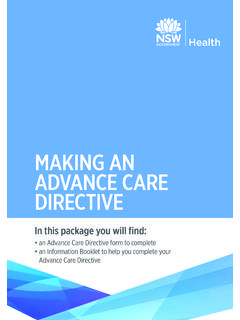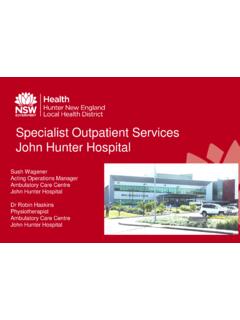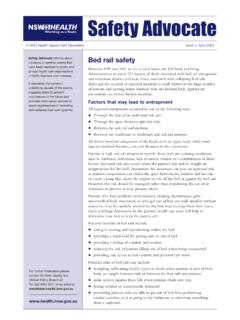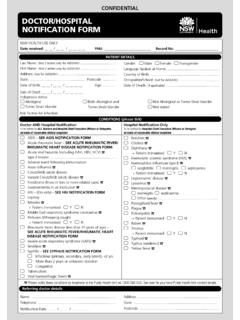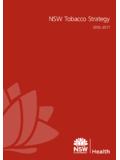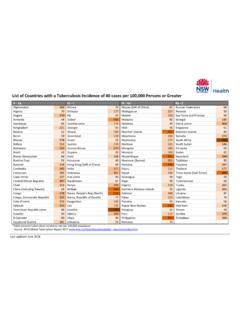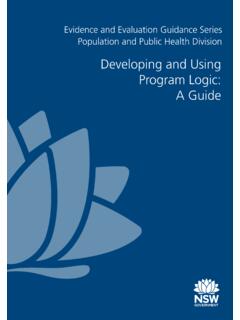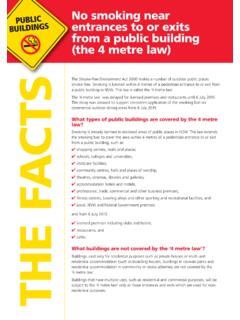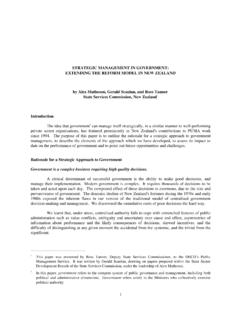Transcription of Emergency Department Models of Care - NSW …
1 Emergency Department Models of care July 2012. NSW MINISTRY OF HEALTH. 73 Miller Street NORTH SYDNEY NSW 2060. Tel. (02) 9391 9000. Fax. (02) 9391 9101. TTY. (02) 9391 9900. This work is copyright. It may be reproduced in whole or in part for study or training purposes subject to the inclusion of an acknowledgement of the source. It may not be reproduced for commercial usage or sale. Reproduction for purposes other than those indicated above requires written permission from the NSW Ministry of Health. NSW Ministry of Health 2012. SHPN (HSPI) 120204. Further copies of this document can be downloaded from the NSW Health website or Emergency care Institute NSW website August 2012. Contents Executive Summary.
2 1. Section 1. The need for Emergency care Section 2. The ideal ED patient journey ..6. Section 3. Emergency Department Models of Section 4. Streamlining access to acute care ..39. Section 5. Other Community healthcare services ..52. Section 6. Monitoring measures ..56. Section 7. Self-Assessment Tools .. 57. Section 8. References ..58. Models of Emergency care NSW HEALTH PAGE 1. Executive Summary Since the publication in 2006 of the Emergency Models of Complete a self-assessment of each relevant MOC to care ' document for NSW Hospitals, the acceptance and identify opportunities for improvement within their own implementation of Emergency care Models have broadened. hospitals, as well as to identify key areas that require This has been coupled with the creation of new Models to ongoing monitoring for their effectiveness.
3 Assist Emergency Departments (ED) to provide safe and timely access to Emergency care . Six years later, After considering the components of each model , the ED. PricewaterhouseCoopers has been engaged to, in and hospital should have a clear understanding of how the consultation with the NSW Ministry of Health (NSW Health), model works, what data is required to demonstrate a need the Emergency care Institute and the community of those for the model , key factors required to implement the model involved in Emergency care , revise this document. and measures to assess the model 's effectiveness. In 2011, NSW Health carried out a review to discover what The Document also describes the benefits and challenges current Models of care (MOC) are in place in EDs and the experienced by EDs who have previously introduced these effectiveness of these Models for managing demand for Models of care .
4 Reflecting on these lessons, the hospital their services. The review identified challenges faced by EDs and ED can plan accordingly for a model 's implementation in the operation of current Models , key principles required in their own location. A case for implementation' is given for Models to operate effectively and monitoring measures for each MOC which will enable the ED and hospital to for ongoing review and quality improvement. The review address key questions related to the need for also aimed to create a standardised suite of Models of care implementation, and hence improve decision-making for to assist hospitals to provide access to timely, safe and planning and implementation.
5 Quality Emergency care and to meet the National Emergency Access Target. Created to support this document is a self-assessment tool for each Emergency model of care . The purpose of the tool Based on this review and our consultations, this revised is to allow Local Health Districts to assess if a MOC is Models of Emergency care Document (the Document) appropriate for their ED or if an implemented MOC is includes ten Emergency Department Models of care and a functioning to its utmost potential. The tool is intended to number that are external to the ED and support the be used at an ED level in a collaborative approach with all hospital in managing demand for Emergency care . Each key stakeholders.
6 model has been designed to facilitate the ideal patient journey through ED. The Self-Assessment tool rates the effectiveness of each model . Results of the self-assessment are then linked to The Document includes Models that are likely to be in place responses based on the key principles described for each in EDs currently and require revision, as well as those that MOC. A robust evaluation of each model can be used to have been newly developed in NSW. It is intended that generate an action plan for an ED to improve the Hospital Executives and the ED use the Document to: functioning of current Models of care being used, or to consider the implementation of new Models . Assess the current Models of care in their Emergency Departments using the given criteria It is recognised that not all of the Models of Emergency Assess the potential to introduce Models to their care are applicable for all NSW Emergency Departments.
7 Hospitals that may improve patient care and flow, the Decisions to implement them will be made based on the patient experience and clinical outcomes staff, patient presentations and space available in the ED to operate each model . PAGE 2 NSW HEALTH Models of Emergency care The demands placed on Emergency Departments are obvious, as are the needs for the efficient use of resources and processes to improve the timeliness, safety and quality of Emergency care . The Models of care presented in this document represent a synthesis of the most current information and analysis of options for the effective operation of EDs. They should be considered an important resource for improving Emergency care for patients, and part of a whole-of-hospital approach that will support the ideal patient journey and achievement of the National Emergency Access Targets.
8 Models of Emergency care NSW HEALTH PAGE 3. SECTION 1. The need for Emergency care Models Emergency care in Australia ED overcrowding has been increasingly prevalent for over 20 years 4,5 . Evidence from initiatives to address Emergency Departments (EDs) are under increasing pressure overcrowding suggests a need to change current practices due to the high demand for ED access to available inpatient throughout the system to meet access targets, make better beds. This lack of available resources to meet Emergency use of resources and maintain the quality of care delivery. demand is leading to crowding and access block resulting in prolonged patients waits for an inpatient bed. The limitations of current ED and hospital processes include: When ED front-end processes are not streamlined.
9 While efforts are being made to address this, including These processes include: patient arrival and triage, improving available bed stock and the development of registration, bed or clinical area placement, a review by hospital avoidance programs, EDs must continue to improve a nurse and the medical assessment. The patient can their operational efficiency. ED presentations across all often encounter lengthy periods of waiting between triage categories have increased in NSW EDs 1, resulting in each of these processes. increased admission workloads, ED crowding and delayed When the patient is assessed by a senior medical officer access to Emergency care . The number of attendances has only after spending considerable time with junior increased to the point that 11 NSW EDs in 2010/11 had medical staff, or other clinical providers, leading to greater than 50,000 presentations 2.
10 Delays in decision-making and implementing treatment. When patients are placed into a bed on their arrival, One way to meet the demand for Emergency care is to regardless of whether their presentation necessitates a optimise ED and hospital bed capacity. The recent National bed. This can lead to subsequent bed block within ED. Health Reform Agreement on Improving Public Hospital rather than the efficient use of beds. Services' includes a measure to improve this. The National When there are an increasing number of Emergency Access Target (NEAT) aims to improve access to undifferentiated patients in the ED waiting room who Emergency care by reducing access block and its associated are at risk of deterioration.
